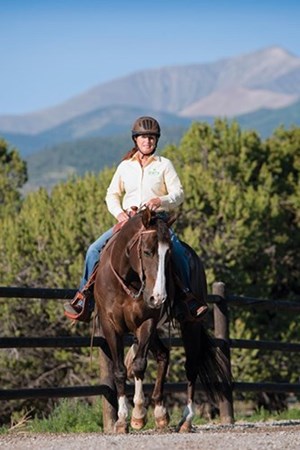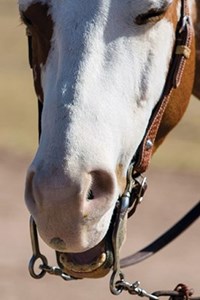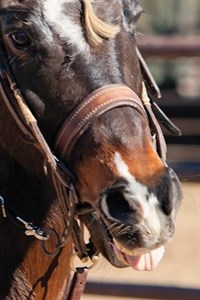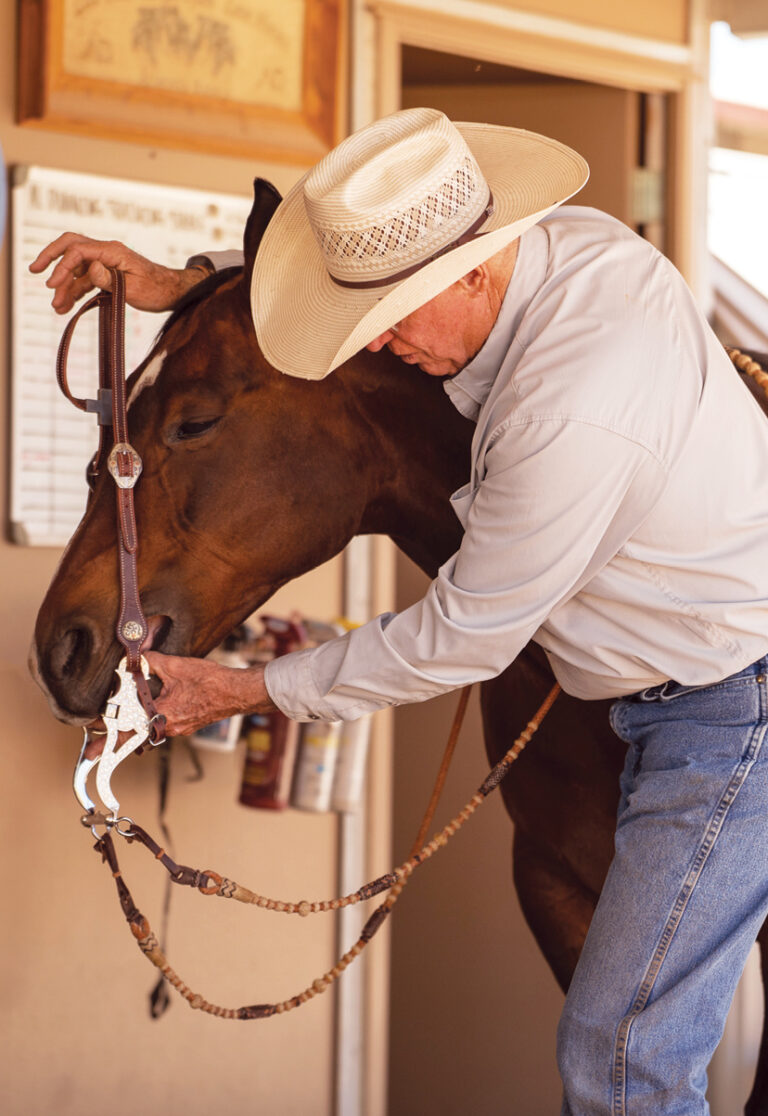Your horse’s bit (or bit-free headgear) is a critical tool for communication and control on the trail.

Your equine trail partner may be wearing the wrong bit if he’s spooky, constantly pulls on the reins, moves in a high-headed “stargazing” frame, is prone to meltdowns, or powers forward too fast.
Here, top trainer/clinician Julie Goodnight will explain how a bit may give you more or less control of your horse and how to identify signs of bit discomfort —and comfort.
Then Goodnight will give you the steps to find a new bit that will allow your horse to be comfortable, relaxed, and in control on the trail.
A Bit on Bits
On the trail, you use your horse’s headgear to steer, stop, and redirect his attention to the path ahead if his attention wanders.
You ride your horse in a bit, or you can ride in bit-free headgear, such as a hackamore, side-pull, a bridle designed without a bit, or even a rope halter. Such headgear controls your horse with nose pressure, (and sometimes chin and poll pressure) rather than mouth pressure.
However, a bit gives you more control and helps you to motivate your horse to perform on a higher level.need to motivate your horse to move precisely around obstacles or steer clear of danger. Or, you may need to motivate him to stay put and face what he’s afraid of instead of bolting away from what he perceives as danger.
The ideal bit is comfortable in your horse’s mouth, thereby allowing him to relax enough to think about your cues. Your riding ability also impacts what bit your horse should wear.
A horse may work perfectly for a seasoned professional with light hands, but the same bit in the hands of a new rider (who may be heavier handed) may be totally inappropriate.
Your horse is a flight animal, so if he’s uncomfortable and worried every time he feels bit pressure, he’s thinking about how to get away from that uncomfortable pressure.
As a result, your horse may develop behaviors and postures that help him momentarily avoid bit pressure. He may even run right through the bit pressure.
Note that changing your horse’s bit won’t fix a training issue. If he doesn’t understand a cue to stop, adding a bigger, more severe bit isn’t the answer; instead, train him to respond to a stop cue.
If your horse doesn’t stop well, doesn’t turn easily, tosses his head, carries his head high with his back arched, or if he’s opening his mouth often, there’s may be a bit problem. He might need a bit that’s more stress-reducing, instead of a bit with more power.
Discomfort vs. Comfort
Your horse will tell you if the bit is uncomfortable through his behavior. These signs include: moving in an inverted posture (sometimes called stargazing or being hollowed out); stiffening his neck or leaning down and rooting the reins out of the riders hands; gaping his mouth; sticking out his tongue or tossing his head.

Your horse may also feel discomfort if he chomps angrily on the bit. This is different from simply playing with the bit or moving a roller.
If you have the right bit, your trained horse should be relaxed, compliant, and responsive to your aids. Hell be soft in your hands, easily turning right and left and stopping without a lot of rein pressure.
If your horse is comfortable, he’ll have a soft, relaxed eye. His mouth will be closed. His lips will be relaxed whether or not you’re applying rein pressure.
If you can say all these things about your horse, don’t worry about your bit. If not, follow these steps to find the right bit for him.
1. Evaluate the Bit
To best evaluate your current bit, enlist the help of a knowledgeable horseperson. This person will be able to see behaviors from the ground that you may not be able to see or feel from the saddle.
Choose someone who knows how to read a horse’s expression and posture. As you ride, ask your helper to see whether your horse’s mouth is slightly open. Is there daylight between your horse’s lips?
Are your horse’s lips tense? Is he tensing or pinching his nostrils? If you look at his eye, is it calm with only black showing? Or do you see the white part of the eye, indicating pain or discomfort? Is he flickering or rolling his eyes?
These are all signs of tension.
Ask your helper to watch for these signs while you walk your horse on a loose rein with his head down, as you turn and stop. Is your horse’s mouth relaxed at this slow gait?
Then speed up and start riding with more contact. Are there more signs of tension?

If your horse holds his mouth slightly open, and you can see daylight through his lips, it means he’s sucked his tongue into his throat to avoid bit pressure. This is very common and usually goes unnoticed, except from the ground. Your horse may be mostly compliant and obedient, but hold this mouth-open pose.
If your helper sees any of these signs of bit discomfort, try a new bit or bitless headgear.
2. Bust Bit Myths
Before you go bit shopping, be aware of these three bit myths.
Myth #1: A snaffle bit is one with a broken mouthpiece.
Busted: A curb bit has shanks that apply pressure on a horse’s mouth using leverage. A snaffle bit has no leverage or shanks. If your bit has a broken mouthpiece, but also has shanks, it’s a curb, not a snaffle.
Without shanks, a snaffle bit provides direct contact from the rider’s hand to the bit’s mouthpiece.
A Tom Thumb “snaffle” isn’t a snaffle at all. Even though it has a jointed mouthpiece, its long shanks actually apply maximum tongue pressure. The joint allows the bit to collapse over the horse’s jaw like a nutcracker and put downward pressure on the tongue, like a nutcracker.
Myth #2: A snaffle is the best bit for all horses.
Busted: This isn’t true. If a well-trained, mature horse is still in a snaffle bit, he may lean on the bit and stiffen his neck. This is a sign that he’s too advanced for the snaffle and would be better off in a mild curb bit.

Plus, when you put pressure on two reins at once with a jointed snaffle, the bit folds in half and grabs at the tongue. With a young horse in training you may need the snaffle’s tongue pressure. But if your horse is responsive, moving to a mild curb bit allows you to use less pressure to get the same response.
Myth #3: The fatter the bit, the kinder it is.
Busted: This is far from the truth. Think about it: In your own mouth, your tongue takes up your entire mouth. Your horse’s mouth is the same way. A big, wide-diameter snaffle is often sold as a “kind” bit. But often those bits crowd the horse’s mouth.
Instead of choosing a fat bit, make sure the bit is narrow enough to fit comfortably in your horse’s mouth.
3. Rule out Physical Problems
If you determine that the bit could be part of your horse’s discomfort or behavior problem, have his teeth checked by a veterinarian before replacing the bit.
Your vet may need to float your horse’s teeth — that is, file off sharp ridges that can cause mouth and bit discomfort.
Also, have your vet check your horse’s overall condition to rule out any physical, chiropractic, lameness, or saddle-fit issues that may be causing training problems.
4. Choose a New Bit
Now it’s time to choose a new bit, or bit-free headgear, for your horse.
Try out several bits to see what works best. Have your knowledgeable friend help you when you try a new bit. Look for the same signs of comfort or discomfort.
Choosing the right bit for you and your horse is an individual decision; there’s no one right answer. As you shop, keep in mind these considerations.
• The type of riding you do. If you leisurely ride down the trail on a calm seasoned horse that’s always in control, you may not need a bit at all. You might like to ride him in a hackamore or other bitless headgear.
But if you want to maneuver through steep terrain and improve your horsemanship with precise transitions or athletic moves, or you ride a green horse, a bit will help you achieve your communication goals.
A bit may also help you keep control if your horse spooks. Consider your stopping power. Make sure you can stop your horse before he bolts.
• Your riding skill. If you’re new to riding or know that you need to work on developing “soft” hands, choose a bit with a short shank or ride in a snaffle side-pull. Bit leverage magnifies heavy hands, and pressure from a rider who uses the reins for balance may be too much pressure for the horse to tolerate.
Consider a longer shank if you’re experienced, balanced, and ride comfortably on a loose rein with your rein hand in front of the saddle horn. This type of bit will allow you to use subtle rein cues; longer shanks magnify bit pressure.
• Your horse’s training level. If your horse is young and/or green, opt for a snaffle or a combination bit (a bit that combines a snaffle with a bosal to provide nose pressure before pulling on the horse’s mouth). The combination bit was designed by the Myler brothers (www.mylerbits.com) to help start colts with nose pressure, then slowly advance to mouth cues without having to change bits.
As a horse matures in his training, he doesn’t need as much bit pressure or contact. The bit should advance with your horse’s training.
The tongue pressure may need to be less as your horse matures and becomes more responsive. Then you may want to use a ported curb bit with more tongue relief and less contact.
For your trained horse, opt for a low and wide port, which provides a place for his tongue, but doesn’t put pressure up into his sensitive palate. As mentioned, shank length has more to do with rider ability.
• Your horse’s calmness level. If your horse is spooky, you may think you need a stronger bit to control him, but this may scare him even more.
With a harsher bit, every time your horse becomes afraid, he also suffers painful bit pressure. This teaches him to become afraid of being afraid.
You actually need a mild bit so that when you do take hold of the reins, the bit doesn’t scare him. The combination bit mentioned above can help your nervous, fearful horse, because you’ll first correct him with nose pressure. He won’t feel mouth contact until he has a chance to first respond to nose pressure.
• Ergonomics. Consider bit ergonomics
— that is, how well it conforms to your horse’s mouth. His mouth isn’t straight across; your bit shouldn’t be straight across either.
To check, put your arm out in front of you, fingers pointed down. Imagine that your hand is your horse’s tongue. Lay a bit over your hand to check its ergonomic shape. Does it nicely wrap around your hand, or do the side pieces stand off to the side?
As you go bit-shopping, this exercise will help you find an ergonomically designed bit.
• Bit quality. The bit’s quality of manufacture is also important. Avoid cheap bits. Avoid chrome-coated bits; the chrome can come off in your horse’s mouth. Keep in mind the bit will go into your horse’s mouth. It’s worth saving up for the best option you can afford.
“I’ve seen lots of defects in cheap bits, whether it’s a jointed snaffle that’s off-center, a bit that has sharp edges, or a bit that breaks in half,” Goodnight says.
Julie Goodnight (www.juliegoodnight.com) lives in central Colorado, home to miles of scenic trails. She trains horses and coaches horse owners to be ready for any event, on the trail or in the performance arena. She shares her easy-to-understand lessons on her weekly RFD-TV show, Horse Master, and through appearances at clinics and horse expos held throughout the United States. She’s also the international spokesperson for the Certified Horsemanship Association (www.cha-ahse.org).




